Cooking for your dog(s) - a basic recipe
I read a very entertaining book a while back called “It must’ve been something I ate” by Jeffrey Steingarten, a collection of essays and the sequel to “The man who ate everything”. In one of the essays, Steingarten describes cooking for his dog, predicated on the idea that commercial dog food is expensive, dogs are omnivorous (to a lesser extent than us but omnivorous all the same) and, perhaps most importantly, it must get pretty mundane eating the same thing over and over. Additionally you never quite know what goes into the dog food (wet or dry) that you buy. Steingarten’s story really touched me and got me thinking about the diet of our two dogs, and since they are a much loved part of the family and I enjoy cooking, I began making all their meals.
We have two adorable whippets - Lotti and Wilkins. Lotti, our first, is six years old and named after a favourite old aunt of my wife; Wilkins is 2 years younger and is named after Sir Hubert Wilkins, the famous South Australian polar explorer (amongst other astounding achievements). Lotti never seemed to have any problems with commercial food but from when we got him Wilkins seemed to get an upset stomach pretty easily and go off his food, so that was another catalyst for starting to cook for them.
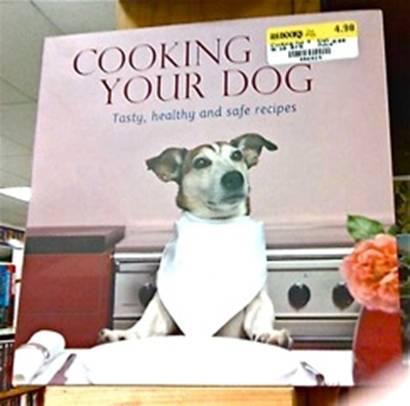 Inappropriately placed price label!
Inappropriately placed price label!
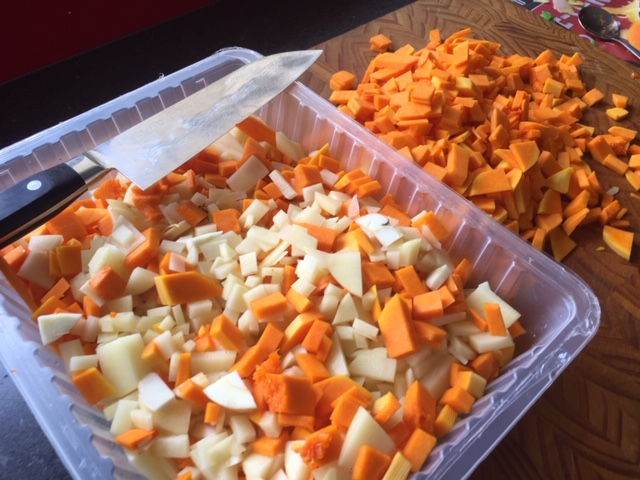 Practice your knife skills when chopping the vegies.
Practice your knife skills when chopping the vegies.
Cooking for dogs gives you a degree of freedom that you don’t normally get when cooking for humans. Dogs don’t care if the vegetables aren’t peeled or the chopping is a bit rough, or you didn’t skim the stock (or if they do they never say anything). Like sneaking vegetables into your kids dinner though it’s best for dogs if you chop them pretty fine to reduce the opportunity to reject them. I enjoy chopping vegetables and things, so it also gives me an opportunity to practise my knife skills and improve speed and technique. When you get really good you can practise what I call “look-away” chopping that the TV chefs do, by not actually looking at the chopping but rather gazing out the window or talking to someone (or talking to camera). In my case it serves very little purpose but it’s a neat party trick, and you know your technique is good if you can do it - you just need your knives to be very sharp. If chopping is not your thing and you’ve got a food processor with a slicer blade then just bung them in there. In the winter time when they’re available one of those soup packs that normally contain an assortment of carrot, potato, celery, turnip and so forth is ideal, which I supplement with a sweet potato or piece of butternut pumpkin. In the summer you just need an equivalent vegetable selection. Be sure to take out the onion - dogs shouldn’t have it.
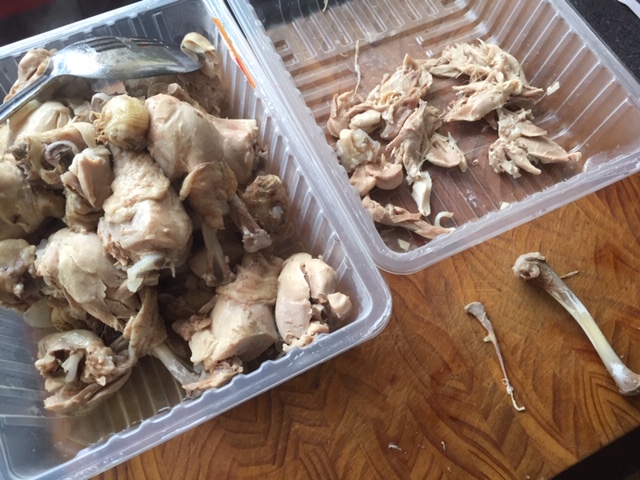 Debone the chicken and pull apart the meat, making sure to get all
the bones.
Debone the chicken and pull apart the meat, making sure to get all
the bones.
Unless I’m feeling really enthusiastic changing the meat in the recipe is the easiest way to provide the variety I’m looking for. I just pick up what’s cheap at the supermarket but tend to cycle between pork and lamb roasts, beef mince and chicken. For the roasts and chicken I do them in the pressure cooker until falling off the bone, then remove the bones and shred the meat, but if you don’t have a pressure cooker just do them in a large stock pot as per the recipe. Mince can just be cooked in the pot before the vegetables. I used to cook whole chickens but now I’ve changed to drumsticks because there’s only two bones, although one is very long and fine so it’s important to get all of them. I do a count so that I’m sure I’ve got one pointy bone for every leg bone.
If you collect and store parmesan cheese rinds in the freezer for beefing up soups and stews, which you should, here’s an opportunity to use some of them up by chucking one or two in the broth. I’ve also experimented with adding small amounts of herbs and spices to the mix but again, the dogs don’t give a lot of feedback so I never really know. I like cinnamon so I occasionally put a pinch or two of that in, and you can’t go wrong with a couple of tablespoons of gravy mix.
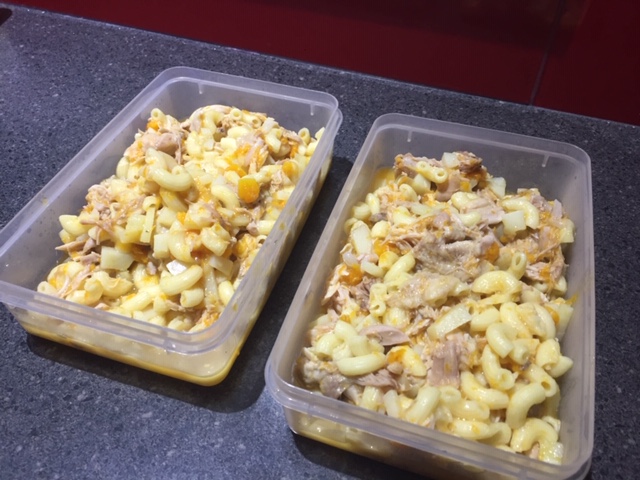 When finished, transfer to containers ready for freezing.
When finished, transfer to containers ready for freezing.
The prepared food is of course entirely edible by you, so if things are desperate or you can’t be bothered cooking you can eat the dog’s dinner! Which leads me to a final word of warning if you have teenagers. I made a batch of this chicken mixture while my son was away on holidays, divided it into containers and put it in the freezer. One of the containers was in the fridge defrosting for the dogs’ evening meal upon his return and, not knowing, he heated it up and ate it for his lunch. It was delicious, apparently, and I’m pretty sure that wasn’t the last time he ate a dog dinner.
Comments or questions? Like my Facebook page.
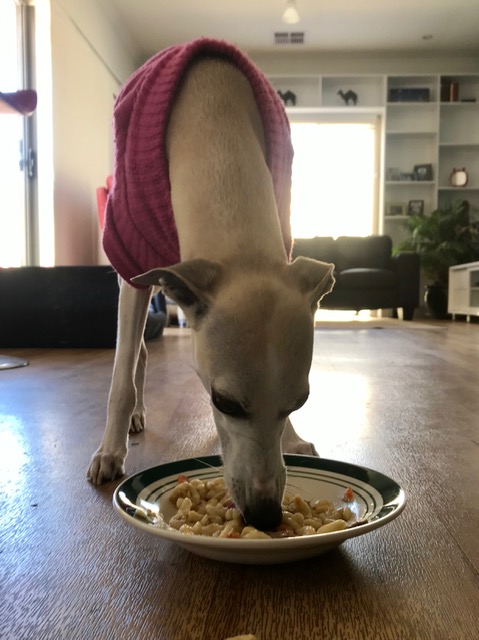 A happy healthy whippet enjoying dinner.
A happy healthy whippet enjoying dinner.
Fancy dinner for spoilt dogs
Cooking: 1 hour 15 minutes
Serves: 2 whippets for 8-10 meals
Ingredients:
- 2kg chicken drumsticks (or other meat - allow a bit more weight for the bones)
- 2 litres water
- Assortment of dog friendly vegetables, finely chopped
- 2-3 parmesan rinds (optional)
- Small quantity of salt or other spices (optional)
- 500g small pasta (macaroni or similar)
Directions
- Place the chicken in a large stockpot and add the water.
- Bring slowly to the boil, reduce heat and simmer for 40-45 minutes to an hour (longer for pork or lamb).
- Remove the chicken pieces from the stock and set aside to cool.
- Add the vegetables, parmesan rind and any seasoning to the stock and simmer for about 10 minutes.
- Add the pasta, stir and return to the boil, turn off the heat, cover and leave for about 15-20 minutes until the pasta is soft and the water has been absorbed.
- Meanwhile, remove the chicken meat from the bones and shred. Discard the bones.
- Stir the chicken meat into the pasta mixture and allow to cool.
- Transfer to suitable sized containers and freeze.
